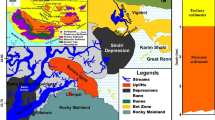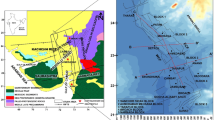Abstract
Gravity data at a grid spacing of 2.5 sq. km., acquired by Geological Survey of India (GSI), have been analysed to discern the subsurface disposition of northern extremity of the Aravalli Delhi Fold Belt (ADFB). Geologically, the area has sparse exposure of the Aravalli Delhi Fold Belt and is predominantly covered by alluvium of Quaternary age. Apart from Bouguer gravity anomaly (BGA) map, residual gravity map, regional gravity map, radially averaged power spectrum (RAPS) and 3D Euler deconvolution maps have been prepared for better insights of the subsurface. Two 2D subsurface gravity models describe possible upwarpment of crustal and mantle materials for gravity high in southwest part of the study area. The significant change in trend of gravity contour pattern from NE-SW to NW-SE near Rohtak and further north is closely parallel to the trends of ADFB and Delhi Sargodha Subsurface ridge respectively. This deflection of the ADFB may probably be caused by rotation related to collision of plates. Earthquake data from International Seismological Centre (ISC), since the year 2000, has been used in the study. The earthquake data shows cluster of shallow focus earthquakes (from 2 to 39 km) with low magnitudes (from ML 1.8 to 5) in the study area near Rohtak. The presence of subsurface disturbance north of Rohtak is well supported by cluster of 3D Euler solutions and distribution of seismicity in that region. The multimodal distribution of the earthquake hypocentres is correlating well with the 2D gravity model along the Bhiwani to Panipat section.
Similar content being viewed by others
References
Arora B.R., Lilley, F.E.M., Sloane, M.N., Singh, B.P., Srivastava, B.J., Prasad, S.N. (1982) Geomagnetic induction and conductive structures in northwest India. Geophys. Jour. Royal. Astron. Soc., v.69(2), pp.459–475.
Arora, B.R., Gahalaut, V.K., Kumar, N. (2012) Structural control on along-strike variation in the seismicity of the northwest Himalaya. Jour. Asian Earth Sci., v.57, pp.15–24.
Arora, B.R., Mahashabde, M.V. (1987) A transverse conductive structure in the northwest Himalaya. Phys. Earth Planet. Inter., v.45(2), pp.119–127.
Bansal, B.K., Mohan, K., Verma, M., Sutar, A.K. (2021) A holistic seismotectonic model of Delhi Region. Scientific Reports v.11, Art. No.13818.
Dwivedi, D., Chamoli, A., Pandey, A.K. (2019) Crustal structure and lateral variations in Moho beneath the Delhi fold belt, NW India: Insight from gravity data modeling and inversion. Physics Earth Planet. Inter., v.297, 106317.
Fairhead, J. D, Greem, C. M., Blitzkow, D. (2003) The use of GPS in gravity surveys. The Leading Edge, v.22(10), pp.921–1056.
Fitzgerald, D., Reid A.A., and Mcinerney. (2003) New discrimination technique for Euler Deconvolution. Comp. and Geosci., v.30, pp.461–469.
Godin, L., Harris, L.B. (2014) Tracking basement cross-strike discontinuities in the Indian crust beneath the Himalayan orogeny using gravity data-relationship to upper crustal faults. Geophys. Jour. Inter., v.198(1), pp.198–215.
GSI (2000) Seismotectonic Atlas of India and Its Environs. Geol. Survey of India, Calcutta.
GSI (2011) Geology and Mineral Resources of Haryana. Miscel. Publi. No. 30: Part — XVIII (Second Revised Edition) GSI-NGRI (2006) Gravity Map Series of India. Geol. Soc. India and National Geophysical Research Institute, Hyderabad, India.
Gupta, S., Mohanty, W.K., Prakash, R., Shukla, A.K. (2013) Crustal heterogeneity and seismotectonics of the National Capital Region, Delhi. India. Pure Appl. Geophys., v.170(4), pp.607–616.
Hualin Zeng, Deshu Xu, and Handong Tan. (2007) A model study for estimating optimum upward-continuation height for gravity separation with application to a Bouguer gravity anomaly over a mineral deposit, Jilin province, northeast China. Geophysics, v.72(4), pp.145–150.
International Seismological Centre (2019) On-line Bulletin. https://doi.org/10.31905/D808B830.
Iyengar, R.N. and Ghosh, S. (2004) Microzonation of earthquake hazard in greater Delhi area. Curr. Sci., v.87, pp.1193–1202.
Kumar, M.R., Mishra, D.C., Singh, B., Venkat Raju, D.C., Singh, M. (2013) Geodynamics of NW India: subduction, lithospheric flexure, ridges and seismicity. Jour. Geol. Soc. India, v.81, pp.61–78.
Mishra, D.C., Singh, B., Tiwari, V.M., Gupta, S.B., Rao, M.B.S.V. (2000) Two cases of continental collisions and related tectonics during the Proterozoic period in Indiain sights from gravity modelling constrained by seismic and magnetotelluric studies. Precambrian Res., v.99(34), pp.149–169.
Nettleton, L.L. (1939) Determination of Density for the reduction of gravimeter observations. Geophysics, v.4, pp.176.
Pavankumar, G., Manglik, A., Demudu Babu, M, Chakravarthi, N. (2021) Magnetotelluric evidence for the presence of a deepelectrical conductor in the vicinity of the Delhi Seismic Zone. India. Jour. Earth Syst. Sci., v.130, Art. No. 79.
Robert J. Geller. (1976) Scaling relations for earthquake source parameters and magnitudes. Bull. Seismo. Soc. Amer., v.66(5), pp.1501–1523.
Roy, A.B., Jakhar, S.R., (2002) Geology of Rajasthan, Northwest India. Precambrian to Recent. Scientific. Publ. (India), Jodhpur.
Shukla, A.K., Prakash, R., Singh, R.K, Mishra, P.S. and Bhatnagar, K. (2007) Seismotectonic implications of Delhi region through fault plane solutions of some recent earthquakes. Curr. Sci. v.93 (12), pp.1848–1853.
Spector, A., Grant, F.S., (1970) Statistical Models for Interpreting Aeromagnetic Data. Geophysics, v.35(2), pp.293–302.
Acknowledgement
The authors thank all the officers worked in Haryana and part of Rajasthan, Delhi and Uttar Pradesh during field season programme from 2002–2018 whose data have been used for the work. The authors thankfully acknowledge the administrative and technical support provided by Geological Survey of India. The authors acknowledge the critical suggestions and assistance of Shri Mehdi Hasan, Suptdg. Geophysicist (Retired).
Author information
Authors and Affiliations
Corresponding author
Rights and permissions
About this article
Cite this article
Singh, K.K., Ranjan, S.K., Biswas, S. et al. Crustal Mapping of Northern Extremity of Aravalli Delhi Fold Belt (ADFB) by High Resolution Gravity Survey in Haryana, India. J Geol Soc India 98, 771–778 (2022). https://doi.org/10.1007/s12594-022-2067-1
Received:
Accepted:
Published:
Issue Date:
DOI: https://doi.org/10.1007/s12594-022-2067-1




